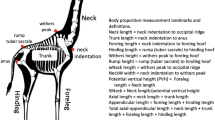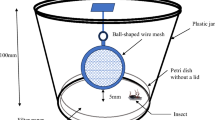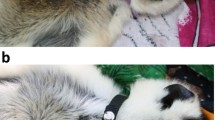Abstract
Sex-ratio studies have played a prominent role in tests of kin selection theory in the eusocial Hymenoptera. The winner in sex-ratio conflict between queens and workers must control the ratio through proximate mechanisms. To determine how a colony adjusts its sex ratio, the mechanism of sex-ratio determination was analyzed in the field in colonies of the ant Camponotus (Colobopsis) nipponicus. A path model including five colony characteristics showed that the resource availability of the colony (quantified as the amount of stored fat in the bodies of the workers) has a large positive effect on the proportion of new queens in the female larvae, but has little effect on male production. The results indicated that a colony adjusts the sex ratio by altering the proportion of new queens obtained from a diploid brood in response to resource availability rather than by eliminating male larvae.


Similar content being viewed by others
References
Aron S., Passera L. and Keller L. 1994. Queen-worker conflict over sex ratio: a comparison of the primary and the secondary sex ratio in the Argentine ant, Iridomyrmex humilis. J. Evol. Biol. 7: 403-418
Aron S., Vargo E.L. and Passera L. 1995. Primary and secondary sex ratios in monogyne colonies of the fire ant. Anim. Behav. 49: 749-757
Backus V.L. and Herbers J.M. 1992. Sexual allocation ratios in forest ants: food limitation does not explain observed patterns. Behav. Ecol. Sociobiol. 30: 425-429
Boomsma J.J. 1989. Sex-investment ratio in ants: Has female bias been systematically overestimated? Am. Nat. 133: 517-532
Boomsma J.J. and Isaak J.A. 1985. Energy investment and respiration in queens and males of Lasius niger (Hymenoptera: Formicidae). Behav. Ecol. Sociobiol. 18: 19-27
Boomsma J.J., van der Lee G.A. and van der Have T.M. 1982. On the production ecology of Lasius niger (Hymenoptera: Formicidae) in successive coastal dune valleys. J. Anim. Ecol. 51: 975-991
Bourke A.F.G., van der Have T.M. and Franks N.R. 1988. Sex ratio determination and worker reproduction in the slave-making ant Harpagoxenus sublaevis. Behav. Ecol. Sociobiol. 23: 233-245
Brown W.D. and Keller L. 2006. Resource supplements cause a change in colony sex-ratio specialization in the mound-building ant, Formica exsecta. Behav. Ecol. Sociobiol. 60: 612-618
Chapuisat M., Sundström L. and Keller L. 1997. Sex-ratio regulation: the economics of fratricide in ants. Proc. R. Soc. Lond. B 264: 1255-1260
Crespi B.J. 1990. Measuring the effect of natural selection on phenotypic interaction systems. Am. Nat. 135: 32-47
Crespi B.J. and Bookstein F.L. 1989. A path-analytic model for the measurement of selection on morphology. Evolution 43: 18-28
Crozier R.H. and Pamilo P. 1993. Sex allocation in social insects: problems in prediction and estimation. In: Evolution and Diversity of Sex Ratio in Insects and Mites (Wrensch D.L. and Ebbert M.A., Eds), Chapman and Hall, New York, pp 369-383
Deslippe R.J. and Savolainen R. 1995. Sex investment in a social insect: the proximate role of food. Ecology 76: 375-382
Fournier D., Keller L., Passera L. and Aron S. 2003. Colony sex ratios vary with breeding system but not relatedness asymmetry in the facultatively polygynous ant Pheidole pallidula. Evolution 57: 1336-1342
Hammond R.L., Bruford M.W. and Bourke A.F.G. 2002. Ant workers selfishly bias sex ratios by manipulating female development. Proc. R. Soc. Lond. B 269: 173-178
Hasegawa E. 1992. Annual life cycle and timing of male egg production in the ant Colobopsis nipponicus (Wheeler). Insect. Soc. 39: 439-446
Hasegawa E. 1993. Caste specialization in food storage in the dimorphic ant Colobopsis nipponicus (Wheeler). Insect. Soc. 40:261-271
Hasegawa E. 1994. Sex allocation in the ant Colobopsis nipponicus (Wheeler). I. population sex ratio. Evolution 48: 1121-1129
Helanterä H. and Ratnieks F.L.W. 2009. Sex allocation conflict in insect societies: who wins? Biol. Lett. 5: 700-704
Helms K.R. 1999. Colony sex ratios, conflict between queens and workers, and apparent queen control in the ant Pheidole desertorum. Evolution 53: 1470-1478
Helms K.R., Fournier D., Keller L., Passera L. and Aron S. 2004. Colony sex ratios in the facultatively polygynous ant Pheidole pallidula: A reanalysis with new data. Evolution 58: 1141-1142
Helms K.R., Reuter M. and Keller L. 2005. Sex-ratio conflict between queens and workers in eusocial Hymenoptera: Mechanisms, costs, and the evolution of split colony sex ratios. Evolution 59: 2626-2638.
Herbers J.M. 1984. Queen-worker conflict and eusocial evolution in a polygynous ant species. Evolution 42: 160-172
Herbers J.M. 1990. Reproductive investment and allocation ratios for the ant Leptothorax longispinosus. Am. Nat. 136: 178-208
Kümmerli R. and Keller L. 2009. Patterns of split sex ratio in ants have multiple evolutionary causes based on different within colony conflicts. Biol. Lett. 5: 713-716
Li C.C. 1975. Path Analysis - A Primer. Boxwood Press. Cambridge.
Morales M.A. and Heithaus E.R. 1998. Food from seed-dispersal mutualism shifts sex ratios in colonies of the ant Aphaenogaster rudis. Ecology 79: 734-739
Mehdiabadi N.J., Reeve H.K. and Mueller U.G. 2003. Queens versus workers: sex ratio conflict in eusocial Hymenoptera. Trends Ecol. Evol. 18: 88-93
de Menten L., Fournier D., Brent C., Passera L., Vargo E.L. and Aron S. 2005. Dual mechanism of queen influence over sex ratio in the ant Pheidole pallidula. Behav. Ecol. Sociobiol. 58: 527-533
Nonacs P. 1986a. Ant reproductive strategies and sex allocation theory. Quart. Rev. Biol. 61: 1-21
Nonacs P. 1986b. Sex ratio determination within colonies of ants. Evolution 40: 199-204
Pamilo P. 1991. Evolution of colony characteristics in social insects. I. Sex allocation. Am. Nat. 137: 83-107
Pamilo P. and Rosengren R. 1983. Sex ratio strategies in Formica ants. Oikos 40: 24-35
Passera L, Aron S., Vargo E.L. and Keller L. 2001. Queen control of sex ratio in fire ants. Science 293: 1308-1310
Pearcy M. and Aron S. 2006. Local resource competition and sex ratio in the ant Cataglyphis cursor. Behav. Ecol. 17: 569-574
Rosset H. and Chapuisat M. 2006. Sex allocation conflict in ants: When the queen rules. Curr. Biol. 16: 328-331
Shaw R.F. and Mohler J.D. 1953. The selective advantage of the sex ratio. Am. Nat. 87: 337-342
Sokal R.R. and Rohlf F.J. 1994. Biometry. Third edition. Freeman, New York.
Taylor P.D. 1981. Sex ratio compensation in ant populations. Evolution 35: 1250-1251
Trivers R.T. and Hare H. 1976. Haplodiploidy and the evolution of the social insects. Science 191: 249-263
Ward P.S. 1983. Genetic relatedness and colony organization in a species complex of ponerine ants, II: Patterns of sex ratio investment. Behav. Ecol. Sociobiol. 12: 301-307
Wright S. 1921. Correlation and causation. J. Agr. Res. 20: 557-585
Acknowledgments
I am grateful to J.M. Herbers, L. Keller and P. Nonacs for critical readings of an early version of the manuscript. I also thank the members of the Kominato laboratory of the Marine Ecosystems Research Center of Chiba University for permission to use equipment in their laboratory.
Author information
Authors and Affiliations
Corresponding author
Rights and permissions
About this article
Cite this article
Hasegawa, E. Sex allocation in the ant Camponotus (Colobopsis) nipponicus (Wheeler): II. The effect of resource availability on sex-ratio variability. Insect. Soc. 60, 329–335 (2013). https://doi.org/10.1007/s00040-013-0297-3
Received:
Revised:
Accepted:
Published:
Issue Date:
DOI: https://doi.org/10.1007/s00040-013-0297-3




